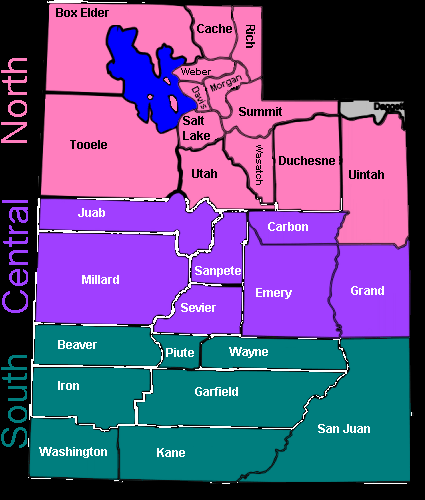 |
- Utah Dialect Divisions
- Utah English can be divided into three regional dialects and two major social dialects. Geographically, the state has two strong dialect
areas (north and south) with a transitional central region that is less defined but still distinct. Northern Utah aligns closely with Midland and
Western American dialects. Southern Utah differs significantly from northern Utah both phonetically and lexically. Central Utah is
differentiated most significantly by phonetic realizations. Click on the map below for information on a specific region of Utah.

- The major social division in Utah speech relates to age, with young speakers using a significantly different dialect than their elders.
Although the dialectal boundary is not abrupt, the most significant change occurs around 30 years of age. This division derives from both
phonetic and lexical differences. Utah speakers also break into significant dialect groups based on population density. Small population
areas (less than 1000 people) are more likely to produce stereotyped phonetic realizations and to deviate from standard Utah terms.
- Characteristics of Utah English
- The most significant characteristic is the laxing of tense vowels. Front vowels are generally laxed before /l/, and back vowels are often
laxed before /r/. Other prominent characteristics include a tendency to pronounce "creek" as /krIk/ and "crayon" as /kr�n/, and to use
creative euphemisms. Phonetic characteristics that were not significant overall but deserve attention include the laxing of tense back
vowels before /l/, the laxing of tense front vowels before /r/, a transition from /Il/ to /ell/, a transition from /or/ to /ar/ in "war," a central offglide
in "pit" and "pet," and the pronunciation of /pIn/ for "pen." In most other respects, Utah follows the phonetic and lexical patterns common
to other areas in the western United States.
- Social Factors Influencing Utah Speech
- Age seems to be the best predictor for phonetic characteristics, with a strong difference between the responses of the oldest and
youngest informants. Gender plays an interesting role in Utah English, as women are more likely to produce stereotyped pronunciations
than are men. Although the difference between the female and male responses is also not statistically significant for most individual
phonetic features, the overall pattern deserves attention. Female informants responded more frequently with nonstandard
pronunciations than did male informants (on ten out of fourteen characteristics vs. four out of fourteen). This pattern reverses the
predictions of current linguistic theory, which expects women to maintain standard usage more consistently than men.
|


 Return to The Utah Dialect Project homepage
Return to The Utah Dialect Project homepage